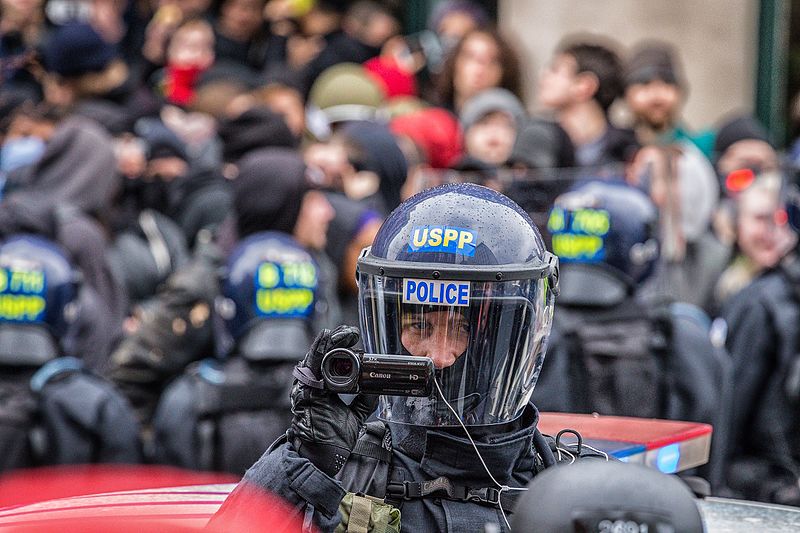Secrecy Creep
The Glomar operates as a powerful tool of government secrecy, but should the Pennsylvania State Police be permitted to append it to every public records response it issues?

Published by The Lawfare Institute
in Cooperation With

In 1968, the Central Intelligence Agency discovered a sunken Soviet nuclear submarine resting deep on the ocean floor. The agency built a 600-foot ship outfitted with a giant claw to raise the submarine to the surface and access the valuable intelligence information contained inside. It then developed an elaborate cover story, convincing Howard Hughes, the eccentric billionaire inventor, to claim that he had built the ship to mine manganese from the sea floor. To help sell the story, the agency named the vessel the Hughes Glomar Explorer.
When word of the project eventually leaked, a group of reporters submitted a series of Freedom of Information Act requests to the agency to ask for information about the covert operation. The CIA didn’t want to deny the request under a specific exemption because that might tip off the Soviets. But to tell the reporters that there were no responsive records would be a lie. So it came up with a new response under the federal transparency statute. It told reporters that it could not reveal whether or not it had records relating to the project because the mere fact of the program’s existence was a classified national security secret. This reply—refusing to confirm or deny the existence or nonexistence of records—has been referred to ever since as the “Glomar” response.
The Glomar’s origins are deeply embedded in the national security context. And for a time, the secrecy tool remained tethered to the national security state. But eventually, it began to migrate—first to other federal agencies and then to state and local governments. Police departments, especially, began to issue Glomars to shield information relating to their investigations. Over time, its use became more widespread, even routine. When I recently asked the Pennsylvania State Police for any records they possessed relating to their use of the Glomar, for example, they responded with a Glomar. They wrote that to the extent my request was seeking covert law enforcement investigatory material, they could “neither confirm nor deny” the existence of such records. It turns out that this language is boilerplate: The agency includes it in every public records response that it sends out.
The Glomar operates as a powerful tool of government secrecy. It may have been justified in the context of a covert operation involving Soviet nuclear weapons. But should the Pennsylvania State Police be permitted to append it to every public records response it issues? Should the agency be allowed to issue it at all? The spread of the Glomar connects to a larger set of questions about the extent to which secrecy protections developed to shield national security secrets should be adopted into state and local contexts. It serves as just one example of the migration of national security secrecy tools into state and local law—a process that I refer to in a recent article as “secrecy creep.” But there are others. The executive privilege recognized by the Supreme Court in United States v. Nixon to shield the confidential communications of the president, for example, has since been claimed by governors and even city mayors. And federal judicial doctrines granting substantial deference to agency claims of national security harm have been adopted by state court judges to shield the records of police and corrections agencies.
In my article, I argue that this migratory pattern is deeply troubling. These secrecy tools were developed in the national security context, and they often embody a legal, historical and cultural tradition that is unique to the federal government. The justifications that undergird these secrecy protections do not always hold up as they cross over into state lines. For example, the presidential communications privilege was justified by the Supreme Court in part because the U.S. Constitution itself was negotiated in secret. Yet many state constitutions were drafted in full view of the public, with transcripts of the proceedings published contemporaneously in local newspapers. This historical distinction does not necessarily mean that the privilege should not be adopted in state law. But it does demonstrate how the pillars supporting these informational protections can begin to crumble as they move into state and local contexts.
These powerful national security secrecy protections are also embedded within a complex web of checks to federal executive power that does not necessarily exist at the state and local levels. Internally, agency inspectors general monitor national security agencies from within the executive branch, and Congress has multiple standing committees dedicated solely to overseeing federal intelligence activities. Externally, a powerful and well-funded national press works around the clock to uncover national security secrets. These various safeguards operate as powerful counterweights to national security secrecy. Yet at the state and local levels, these restraints on executive power are often much weaker, if they exist at all. Many state legislatures meet infrequently—some for only a few months every other year—and they often dedicate few if any resources to sustained executive branch oversight. External checks are likewise reduced. Local media are in a state of crisis, and many smaller towns and cities now qualify as news deserts, without any local media presence at all. Government officials in these places are already nearly immune from public scrutiny. They don’t require any further defenses, much less access to robust informational protections designed to shield the nation’s most sensitive secrets.
Moreover, once these protections cross over into state and local contexts, it can be difficult to cabin their further spread. Law enforcement is often the point of entry for these tools. Police departments observe the CIA or FBI invoking a novel protection and then seek to obtain access to the secrecy innovation as well. But once these informational protections enter into state law, they rarely stay put. They spread both horizontally, to other agencies within that same level of government, and vertically, from the state to the local context and vice versa. The presidential communications privilege offers an example. State courts adopted the privilege to shield the communications of governors, reasoning that while state executives may have reduced responsibilities and authorities compared to the president, they nonetheless face many of the same pressures and sensitivities as the federal head of state. Yet the privilege has not remained confined to this context. Instead, city mayors have begun to claim the executive privilege too, arguing there are substantial similarities in the duties exercised by state and municipal leaders.
Yet once these protections migrate further into the state or local realm, they often become co-opted to shield information that is merely embarrassing or politically harmful. Consider the example of then-Mayor Cory Booker’s efforts to withhold communications with Mark Zuckerberg about the tech founder’s $100 million donation to the Newark school system. Booker’s office claimed that these materials were protected by executive privilege. But once the emails did come to light, it became clear that they contained few of the sensitive deliberations that the privilege was intended to protect. Rather, they were concerned mostly with Booker’s effort to court various other wealthy donors.
Finally, the legal and physical infrastructures of the national security state often travel hand in hand. As state and local police departments gain increased access to the weapons and surveillance technologies of the military national security state—a process referred to as police militarization—they also gain access to these federal secrecy tools. The Stingray device, which allows government officials to intercept cell phone communications, offers an example. After police departments acquired this surveillance technology, they borrowed federal secrecy tools like the Glomar to shield the device from public view. These secrecy tools, in turn, make it easier for police to gain access to new surveillance technologies without facing public resistance. In Seattle, for instance, the widespread outcry over the police department’s purchase of two unmanned aerial vehicles eventually led the department to give the surveillance drones back. But if the public is not aware of a new police surveillance tool or device, it cannot object to its adoption or use.
Importing federal secrecy tools into state and local government has had various negative and unanticipated effects. The question is what can be done—how these national security secrecy tools might be cabined going forward. There are two possible avenues for reform. The first would be to constrain these secrecy powers directly. State governments, in particular, could take steps to limit the spread of these federal protections. Legislatures could amend public records statutes to prohibit the adoption of certain legal doctrines or tools, or at least make clear the permissible circumstances of their use. They could also overrule judicial adoptions of federal secrecy tools. This has happened before. When the Virginia Supreme Court adopted into state law a doctrine of substantial deference to executive claims of national security harm, for example, the state legislature overrode the decision through a statutory amendment to the state public records law.
Judges can also play a role. They can and should take more seriously claims that these secrecy tools are ill suited to the state and local contexts. A series of vigorous dissents to state supreme court decisions adopting the federal executive privilege to the state context offers an illustration. These judges have pointed to various distinctions in state constitutional structure, history, and practice that warn against the wholesale adoption of the presidential privilege outlined in United States v. Nixon. Although these arguments did not ultimately carry the day, they nonetheless illustrate how judges can serve as a brake on the unchecked spread of federal secrecy powers.
The second path would be to address the harms of secrecy creep indirectly, by ramping up alternative methods and channels of government oversight that act as a counterweight to increased secrecy powers. These efforts, too, could take different forms. Increased intergovernmental checks—improved state legislative oversight of the executive branch, as well as more robust state executive oversight of local police—could help to counteract the secrecy effects of these tools. State and local governments could experiment with structural accountability mechanisms such as agency inspectors general. They could also reduce the scope and frequency of federal-local law enforcement cooperative efforts, thereby disrupting the weaponry-secrecy feedback loop that has helped to accelerate secrecy creep.
Taking steps to address the collapse of local media could also help. Even the most well-structured intergovernmental checks often cannot compare to the muckraking powers of a well-resourced and motivated press. Fixing the press is a monumental task—one too complex to tackle here. But scholars and policymakers have offered promising avenues for reform. These proposals include increased governmental and nonprofit funding for local journalism, new tax incentives to encourage people to subscribe to papers, or new statutes limiting platforms’ ability to profit from content generated by the news media. Reversing the decline of local news could help to counteract the worst effects of secrecy creep as well.
Ultimately, some combination of these efforts, from both inside and outside of government, will likely be needed to slow the movement of powerful national security secrecy tools into state law, as well as to mitigate its harmful effects. But illuminating this migratory channel serves as a crucial first step. Only then can policymakers take measures to constrain these secrecy tools and prevent state and local governments from slipping further from public view.



.jpg?sfvrsn=676ddf0d_7)

